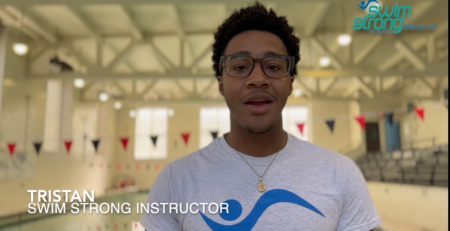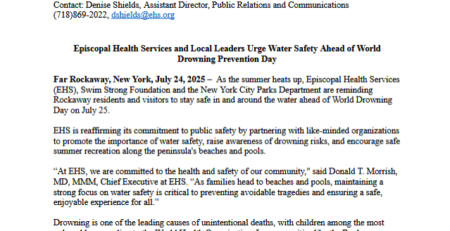We Need A New Relationship With Water
We have just passed the 7th Anniversary of the devastation of Super Storm Sandy. 7 years later there is still much work to be done. The City agencies are taking steps to protect our land and buildings. However, our most vulnerable assets, our people are not being thought of in these plans.
Multiple layers of protection are needed to help us be safe in and around the water. Swim Strong Foundation delivers two of those layers by teaching water safety and strong swimming skills. It is an unfortunate reality that not everyone will learn how to swim. However, we ALL can learn about the dangers of water from within our own homes to everywhere we meet it out of doors. Our DRY side educational program is called “Know Before You Go”. It speaks to the nature of water in each of it’s different environments (pools, rivers, lakes, oceans, etc). This knowledge gives us the ability to make decisions that keep us safe.
Water safety education is NOT just a conversation for the Summer. Just this month alone we had three children drown, two in the Rockaways and one in the Hudson. Fall is hurricane season, making our open waters much rougher. Over the past several years we have had spikes of warm weather days into November. Our water temperatures are still reasonably warm. People are drawn to our beaches and rivers etc, often with tragic consequence. In the Winter, we have many people falling through the ice. In Spring, we face flooding.
The importance of water safety should be as innate to us as the putting on of a seatbelt when we get into an automobile. Swim Strong Foundation asks the government agencies at both the City and State level to mandate the teaching of “Know Before You Go” within our schools and other public venues. All New Yorkers need to be safe in and around the water.
Understanding the Need for DRYside Water Safety Training
Did you know that every 70 seconds a person dies due to drowning? Yes, that is roughly one person per minute around the world. And for every death, 5 more people are suffering life altering brain and spinal cord injuries due to water based accidents? Drownings and water based accidents are a global epidemic. And while those statistics are so disturbing, perhaps the most shocking of all is that 95% of those incidents actually never needed to have happened. They were preventable!
Here in NYC our waterfronts are being developed as never before in our life times, opening up the access to open water dramatically. This open access is wonderful for the person who understands that environment and has the skills to successfully navigate that. But for every one of those people, there are a hundred thousand more who do not have that knowledge or skills. As a result our drownings and water based accidents rates will sky rocket. In addition, we are being dramatically impacted by our water levels raising an inch per year. In 30 years, we will have a Sandy event every day at high tide! Our “super” storms are becoming more intense, not less.
How do we address this? City government is addressing our hard assets, land and building issues. But nothing is being done to help our most precious assets, our families. Our families need to understand that water safety and swimming skills are as important as buckling up your seatbelt when you get into an automobile. That indeed, it is not one solution, but multi layered solutions that are needed to bring NYC families aquatics IQ up to a level of safety.
Some of those solutions are simple, such as better signage at access points to water; use of technology to push water conditions to our cellphones; lifeguards on the beaches longer; media campaigns on public transportation; in social media and on billboards around the city; helping to make swimming lessons more accessible and affordable and what I want to specifically address here is education through DRYside water safety training.
On a practical basis, we understand that not everyone will learn how to swim. However, everyone can learn about the dangers that water represents both inside our own homes and outdoors in the many ways we encounter water. If we understand how water manifests in these different environments, we can make better decisions that will keep us safe in and around water.
For example, drowning is a leading cause of death for children ages 5 and younger; with most of those children dying in their very own homes. First thing that may come to your mind is that these deaths are the result of people with backyard pools that are not properly fenced in. But unsecured pools are not the only problem. Child drownings also happen in bath tubs, where parents get distracted and leave the child unsupervised or in the charge of a slightly older sibling, who should never be responsible for a younger sibling. Another common and seldom considered danger is toilet bowls. Who knew that throwing your toy into the toilet and then retrieving it could be so much fun? A toddler’s heaviest part of their body is their head. If they get upended, and no one sees them, they can not right themselves. It only takes 2 minutes and 2 inches of water for ANY of us to drown. Buckets are a similar problem.
Drowning disproportionally impacts children of color. The statistics show that drowning is the 2nd leading cause of death for children 14 and younger with children of color drowning 5 times more frequently in swimming pools and 3 times more in open water than their Caucasian peers.
And this is not just a problem with young children. Drowning is the 2nd leading cause of death for children 14 and younger and it continues to be a problem from mid-teens to adulthood.
Drowning is also a leading cause of death for children on the spectrum.
Teaching water safety training in ALL of the schools, public and private, is one of the best layers of protection we can provide to our families. As you know we had the recent tragic loss of two teenage boys who drown in the Rockaways and a youngster in a boating accident in the Hudson. Each year we lose several people in NYC who access our water when there are no life guards on the beach and we can’t patrol the beaches 24/7. We can educate people to understand the danger of water and the risks they will take if they choose to go in it.
Water safety training is NOT a conversation we have only in the Summer. Now in the Fall, we are in the middle of hurricane season, making our ocean waters much rougher and more lethal. Also our air temperatures are warmer much longer, encouraging many of us to take advantage of another beautiful beach day. Of course there are no lifeguards on the beach. Even just wading knee deep in the water creates an opportunity for us to knocked off our feet and dragged out to sea.
In the Winter, we need to help people understand the danger of ice and not going out on it. Each year, we drag several people, who have fallen through ice, out. Some do not survive. In the Spring, we have flooding and the need to understand when it is not safe to cross water.
Swim Strong Foundation has a DRYside training program that we have been teaching in about one dozen schools over the past several years. This program addresses water threats in our homes; at swimming pools, oceans, lakes, rivers, ponds and more. There is a pre quiz meant to assess current aquatics IQ; a post quiz to be given immediately after the presentation and a 6 month follow up quiz given to check for retention. Through the Q and A and sharing of students stories and personal experiences, the children are understanding water in a very different, meaningful way.
I am bringing this issue to you, the members of the Waterfronts Committee, so you do not overlook the need to include the protection of NYC greatest assets, our families, as you are shaping the city’s response to being a premier, coastal city for the future.
No one goes to the water and expects a bad outcome. Swim Strong Foundation is already assisting with not only it’s affordable in water programs; but also “Know Before You Go®” our DRYside training for children and adults. TOGETHER, with your help, we can make a true difference in the safety of all our New York families.





